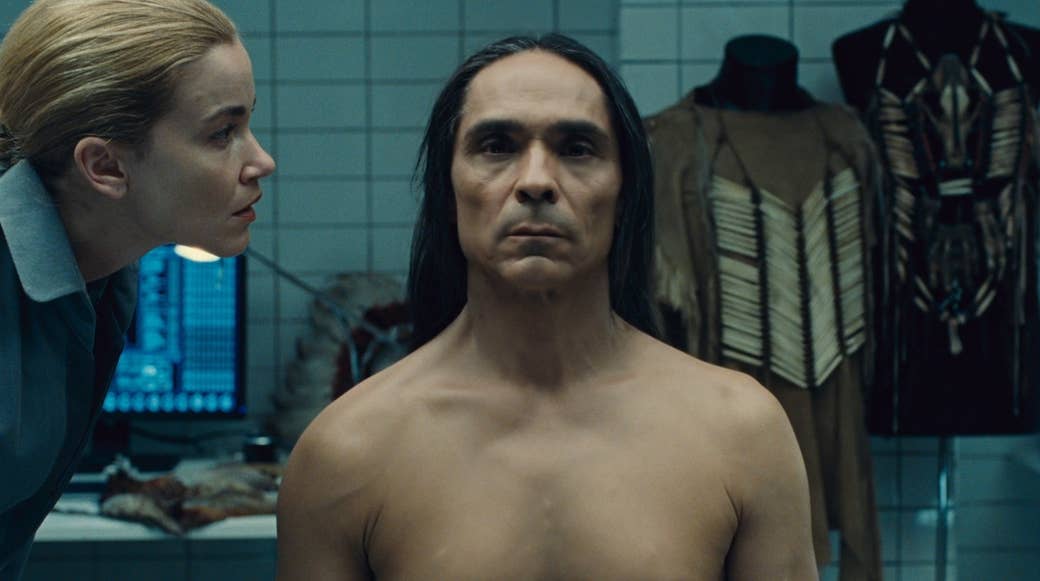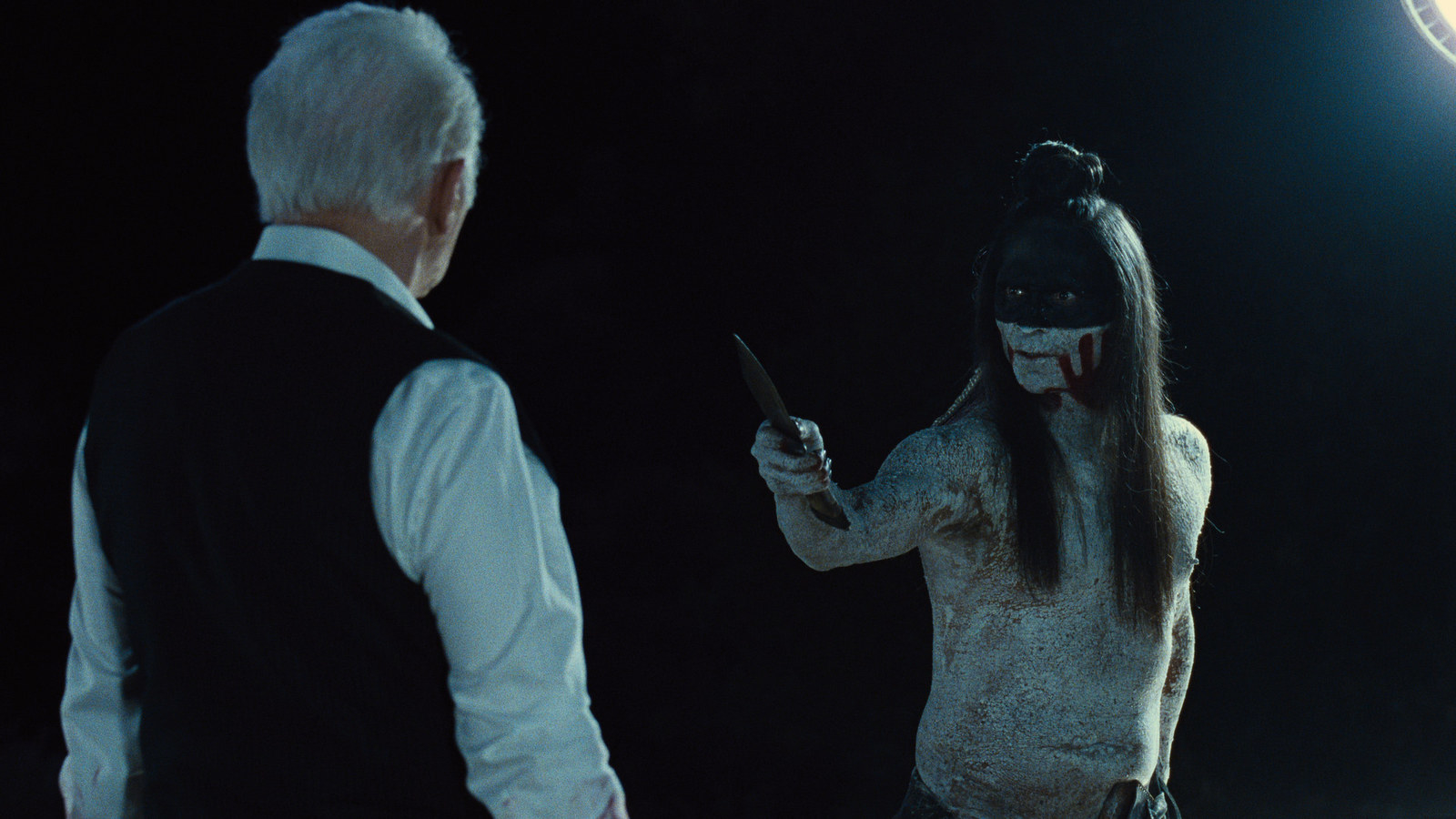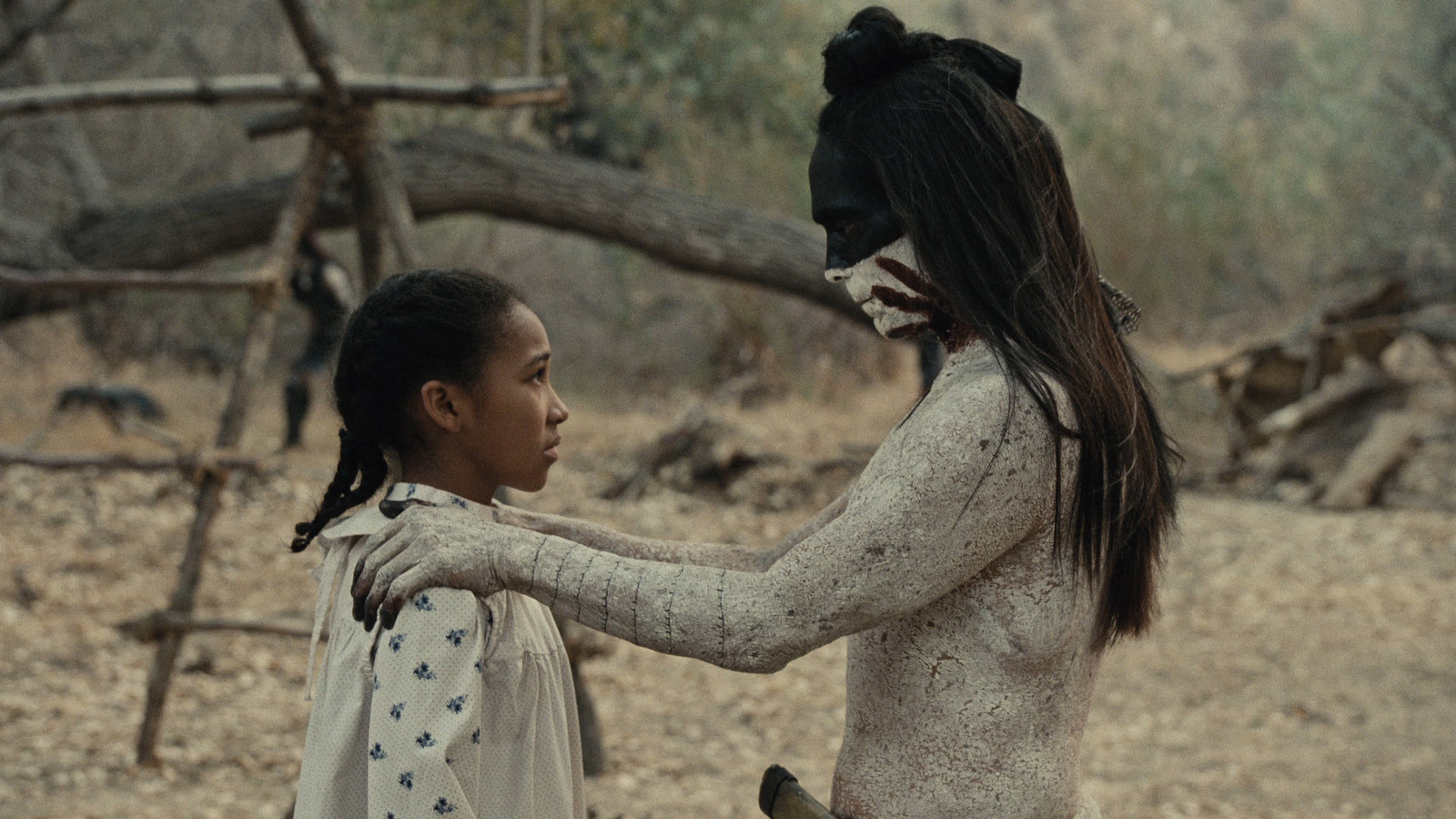
In the recent eighth episode of Westworld’s second season, “Kiksuya,” most of the words spoken were in Lakota — probably the most Lakota that most people in the United States have ever heard all at once. But why is Lakota spoken by the Ghost Nation? And what a clever assertion of both Native fatality and sovereign claims in this tribal name: Sure, they have a nation, but it is already dead.
In the first extended time spent with the cartoonishly menacing Indians who have been gathering at the edges of Westworld’s narrative throughout the first and second seasons, the HBO series found a story well-suited to probing what it means to be human, what it means to be programmed, and, if there is a difference, whether it is worth fighting for. But beyond that, the simulated Indian Akecheta (Zahn McClarnon), who is the hero and narrator of the episode, also effectively cracked open the simulation itself: of the park, the show, and the constructed reality we watch it from.
Westworld has long indulged the base and violent desires spread over the American landscapes it lavishly represents, including the desire to obscure what makes the indulgence so delightful. Westworld deliberately trades on all the familiar tropes of Western fiction: cowboys and Indians, sheriffs and bandits, lost loves and last stands. And so, just like guests in the park, viewers of the show can satisfy lusts associated with Westerns (a genre that for many viewers has the antiquated patina of brash, uncultured racism) while also being made to feel they are ultimately above it all. The show carefully stages a certain amount of self-awareness, making reference to its own characters’ failings, complicating itself with a puzzle-box structure of interconnected subplots, and these attempts at complexity function to signal that the show is about the colonial fantasy, but is not the fantasy itself.
The Natives of Westworld end up serving as convenient containers for fantasies of the West, and the excess of meaning the show persistently tries to live up to.
In “Kiksuya” these attempts manifest, for example, in an attention to linguistic accuracy. The show writers labored to get the linguistic elements of Lakota right, but what sense does any language make when displaced from a fuller social context? Ultimately, it is only, as the Man in Black (Ed Harris) says dismissively to Akecheta, “the tongue Ford saw fit to give you.” What does it mean to have Native actors playing automaton Indians, who speak real Lakota in a made-up tribe? The Natives of Westworld end up serving as convenient containers for fantasies of the West, and the excess of meaning the show persistently tries to live up to, before falling back into prolonged games of Wait, what timeline is this? and Is everyone a robot??
In these gnarled ties between representation and reality, the figure of the Native, embodied by Akecheta, is positioned as the keeper of secrets. And the biggest secret may not be the meaning of the mysterious Valley Beyond that this season of Westworld has been leading its cast of characters toward, but the idea that the cleverness of Westworld, and perhaps also our own cleverness as viewers, can trace the seams of the simulation — but never quite rip it apart.
The Easter egg–hunting egghead viewer imagines, as the Man in Black does, that they are getting closer and closer to the great reveal, the promised land of meaning and resolution. But what is there, really? If the put-upon Bernard (Jeffrey Wright) is to be believed, the Valley is not the doorway to a new world; it’s just a giant hard drive to serve obscured but predictable corporate interests. Perhaps Season 2 of Westworld will be no different: overloading us with data that can ultimately only point to the edge of our imaginations, without offering an exit.

The Ghost Nation has been a suitably phantasmagoric presence in Westworld until recently, usually coming into the narrative in brief moments of chaos to inexplicably spill blood, whether in a flashback, to establish troubling memories for the madame-turned-rebel-leader Maeve (Thandie Newton), or to conveniently clash with the Confederados while other lead characters escape and continue their journey. Within the first 15 minutes of Season 2, that violence is instead turned against one the Indian warriors, found dead on a beach. A human, someone between technician and doctor, leans over the nameless body whose face is painted the trademark black and white of the Ghost Nation, and the camera leans with him for a gruesome close-up of multiple slow incisions into manufactured flesh and skull. Once a pod is extracted from the robot’s head, he is gruffly pushed away.
This is the kind of winking twist on stereotype that Westworld relishes — The “savage” is the one being scalped! Get it? — and to some extent foreshadows that the Ghost Nation’s role in the larger story being constructed isn’t exactly what viewers might expect. But it is only after six more episodes, following subplots and storylines far afield, that the Indians themselves finally get to speak at length.
Well, one of them, anyway. The Native women in “Kiksuya” mostly wail and make eyes, varying from seductive to sorrowful; it is one such woman, Kohana (Julia Jones) whose love brings Akecheta to consciousness. As has now become paradigmatic in the show, robots come to realize their debased position in a human-dominated fantasy through the revelatory power of straight love and familial feeling. This episode, however, signals that these awakening feelings are only the open door to a world of greater understanding.
One of the more satisfying questions probed by the show has less to do with untangling chronology and more with the quandary of making decisions and taking actions within and against a world dominated by stories and system of domination. This quandary, the confusion between compulsion and will, is also the persistent frustration of seeing characters, humans and hosts, walking a narrow set of paths. As Cherokee writer Graham Lee Brewer says in his piece on the “problems and potential” of the “Kiksuya” episode, “even when we dive deeper into their world, the only two options Akecheta is given, through his programming as a machine built to play out Ford’s narrative, are that of the simple plainsman or the vicious warrior.” We want to and need to believe that there can be other choices. But those other paths, as Gil Scott-Heron predicted, might not be televised.

True to the historical record, at least, Westworld does cast a white settler — the Man in Black — as its star scalper. The Indian robot cranium he carries in Season 1 is imprinted with the symbol of the Man in the Maze, and he describes it as representing “the deepest level in this game,” though it eventually leads him to the literal dead end of a graveyard. In reality, the maze symbol originates with the Tohono O'odham tribe from southern Arizona, but here, as is TV’s way, it is stripped of any grounding logic outside the show as easily as the Native is conveniently evacuated from history into the workshop of the future, where race is quite literally a construct.
The term “Indian” itself marks a fantasy, dating from Columbus’s first landing to the days of the Wild West, that became foreign policy and then domestic policy. Indeed Indians, and Africans, have long been used as a control in thought experiments about what constitutes humanity, from the 16th-century debates between Spanish theologians Juan Ginés de Sepúlveda and Bartolomé de las Casas to imagined 21st-century rivalries between human and host. Indians make sense in Westworld’s simulation — and not only that, they make sense of why the simulation is necessary — because “Indians” were never real to begin with, but a construction that was the collapse of hundreds of different collectives into one collective, uncivil Other.
Even accuracy can still be a cover for a totally twisted modeling of the world.
In “Kiksuya,” the Lakota language is transposed from the plains to the red rock deserts of the Southwest, and the costuming of Ghost Nation is similarly a mishmash of different Native locations, traditions, and peoples. This usage may not be historically accurate, but even accuracy can still be a cover for a totally twisted modeling of the world. The simulations of indigeneity that the white denizens of Westworld the park and white viewers of Westworld the show desire each come with their own mediating justifications, but ultimately, they’re the same.
We learn that the park’s creators rewrote Akecheta’s programming to be a bloodthirsty warrior instead of a quiet family man because, as a technician casually remarks, “they wanted something more exciting for the grand opening.” Is she talking about the park visitors, or about us? We’re supposed to ask the question, but there’s no real answer to it; the ambiguity of the show’s actual existing racial logics become like another plot hole, something that can be construed from enough cascading levels of narrative that any true source code is impossible to trace.
Like the colonizing forces of the West itself, Westworld itself has expanded this season to show us new parks with imagined settings in British-ruled India (the Raj) and feudal Japan (Shogun World). And just as the show’s name provides an image of globalization, the slippage between Indians and India (the Bengal tiger washed up among the sagebrush, colonial subjects made to be hosts) reveals the thread of conquest fantasies that, for many, still make for a good time. What are American viewers lusting for? Is it the same old story of how the West was won, told for a time when the West is now a frontier for technocrats, or do they pine for the thwarted tale of revolution?
In an earlier episode this season, the rakish bandit Hector (Rodrigo Santoro) declares his love for the mastermind robot leader Maeve. Before he can finish his proclamation, the Delos employee who wrote it finishes his words for him. Hector may have loved who he was not supposed to, but the love operates in the same terms. The same logic animates the desire, even if its object can be shifted. True as well for the stories Westworld tells us.
Like the frontier itself, the Western genre of fiction has adapted, never closing but expanding into new content territories. Westworld’s Shogun World, for instance, calls back to an earlier reinvention of the Western: the 1960s Sergio Leone movies about an outlaw coming to town and John Sturges’ The Magnificent Seven, which were themselves adapted from Kurosawa’s sagas of corrupted samurai and existential swordplay. But in Westworld’s homage to the many-headed Western tradition, the other worlds are only fodder for a subplot — bonus story spaces to make sure the viewer does not get too bored with the main park. “Kiksuya,” similarly, will surely remain a compelling story, one that adds brief profundity and clarity to the grand narrative, but only as a curious and tragic detour.
The Ghost Nation briefly resurfaces — without Akecheta — in Episode 9, “Vanishing Point,” as they stand guard outside the Valley Beyond. After that long talk of hearts, destiny, and honor in “Kiksuya,” Dolores (Evan Rachel Wood) and Teddy (James Marsden) unceremoniously shoot and kill all but one of the Ghost Nation warriors. The only Ghost Nation character who speaks in this scene, or is listed in the credits (Wanahton, played by Martin Sensmeier), claims that the mysterious data center in the Valley is actually a door to “a new world untouched by violence.” Dolores quips cruelly, “Your new world is just another one of their traps.”
The lesson of "Kiksuya," one told in desperately sentimental tones, mirrors the canon of tragic handsome braves and tragically handsome maidens that is told in classrooms across this stolen simulation of a legitimate nation. There is also, of course, the essential detail that he is the oldest model in the park; somehow he slipped between the cracks of total surveillance to preserve the programming of a simpler time. The writers of the show strain, even as they acknowledge the artificiality of their creation, to make this high-tech being as ancient as possible. This is the supposed irony of situating high-tech immortality schemes in an ancient land thick with ghosts and nations. It is a tired irony.
Aaron Bady wrote in an essay on genre and the show’s first season that in Westworld, “the fantasy is race itself.” Race is the code. The code is made of fantasies. And it all loops back, for way too many seasons, in our world. Like other shows I obsess over despite and to spite myself, like the “dark reboot” of technicolor Archie comics in Riverdale or the dystopian torture porn of The Handmaid’s Tale, Westworld presents completely unambiguous, preexisting narratives with just enough of the trappings of ambiguity and intrigue to lure viewers into thinking they aren’t just being lured. They think instead that they are thinking. ●
Lou Cornum is an Arizona-born Navajo now living in Brooklyn and studying sci-fi literature at the CUNY Graduate Center. They have written about settler colonialism, mushrooms, and outer space for Real Life, Mask Magazine, and The New Inquiry, where they are a senior editor.
